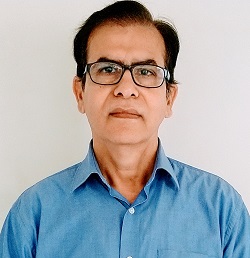
Prof. J R Bhattacharya is a scholar of Sanskrit, Prakrit, and Pali, with a research interest in Jainism and Buddhism. He is currently associated with the Department of Sanskrit, Pali, and Prakrit at Visva-Bharati University, Santiniketan (West Bengal). Before that, he was teaching for almost two and a half decades at Jain Vishva Bharati Institute, Ladnun (Rajasthan).
He has published several articles and books in the field of historical linguistics, Jain canons, and Jainism with comparative religion and philosophy. Some of these include the translation of Daśavaikālikasūtra, Hemachandra’s Prakrit Grammar and publication of the manuscript of Praśnavyākaraṇasūtra. Apart from attending many national and international conferences in India and abroad, he has delivered guest talks in different universities and institutions in Japan, Italy, the UK, Finland, and Australia. He has been teaching the Prakrit language in the summer schools organized by the B L Institute of Indology (New Delhi) and the Institute of Jainology (London).
Prof. Bhattacharya is an associate member of the Centre of Jain Studies, School of Oriental and African Studies (SOAS), University of London, UK, and also a member of the Board of Development of Prakrit Language, Ministry of Human Resource Development, Government of India.
Abstracts of the Lectures
Jain Canonical Literature
Jain canonical literature largely comprises the religious sermons attributed to Lord Mahāvīra c. 600 BCE. Those were composed by the Gaṇadharas (Chief disciples of Mahāvīra) in Ardhamāgadhī Prakrit. The religious discourses of Mahāvīra were in vogue for 900 years through oral tradition. These were composed in written form in 4th century CE in the fourth religious convention held in Valabhi under the patronage of Devardhigaṇi Kṣamāśramaṇa; even earlier, they were classified into Aṃgapraviṣṭa (inner corpus) and Aṃgavāhya (outer corpus). These canonical texts are the source of the philosophy and the religion of the Jains. Lord Mahāvīra preached his religious doctrines in Ardhamāgadhī (an eastern variety of Prakrit).
The Śvetāmbara canonical texts too are composed in Ardhamāgadhī. Ācārāṅgasūtra is said to be the earliest canon holding the archaic form of the Ardhamāgadhī in its feature. As the tradition of compilation of the canons are verbal (Guru-śiṣya paramparā) throughout the ages, the final composition in a written form is found with variations in its nature. The language of the Ācarāṅgasūtra is quite different than that of the later canons. It is believed that the four canons, such as Ācārāṅgasūtra, Sutrakṛtāṅgasūtra, Uttarādhyayana, and the Dasaveyāliya hold the feature of the canon in terms of language and the content holds the originality. Jain canons basically deal with the ethical doctrines of the ascetics and the laities on one hand, and other aspects of philosophy, sociological and cultural studies on the other. Their literary value has contributed to their unique identity.
Prakrit Dramatic Literature
Although the Vedic literature contains a dramatic element, dramas that fulfill the theories of dramaturgy can be found in the works of Aśvaghoṣa (2nd-1st century BCE) and Bhāsa (1st century BCE to 1st century CE). Bharata (3rd century CE) is the earliest dramaturgist to prescribe the rules of the drama. Besides, he prescribes the language of the characters in the drama. In Sanskrit dramas, the Sanskrit language is prescribed for characters such as gods, sages, brahmins, and kings. With the king, the queen and jester, etc. speak Śaurasenī (a kind of Prakrit) or its sub-dialects. So-called minor and unimportant characters speak different types of Prakrit. Rhetoricians and dramaturgists of later periods prescribe different types of drama called rūpakas. There are ten types of major rūpakas and many uparūpakas (minor rupakas). Saṭṭaka (one type of drama) comes under minor rūpakas. Here all the characters are prescribed the Prakrit language as their speech. Rājaśekhara (10th century CE) was the first composer of a Saṭṭaka, named Karpūramañjarī. The tradition of Sanskrit and Prakrit drama has an important place in Sanskrit literature throughout the ages. Unlike Sanskrit, Prakrit has many varieties, such as Mahārāṣṭri, ŚaurasenI, Māgadhī and their sub-dialects that are used in the dramas of the ancient period, which depict the cultural status of the society of those times.